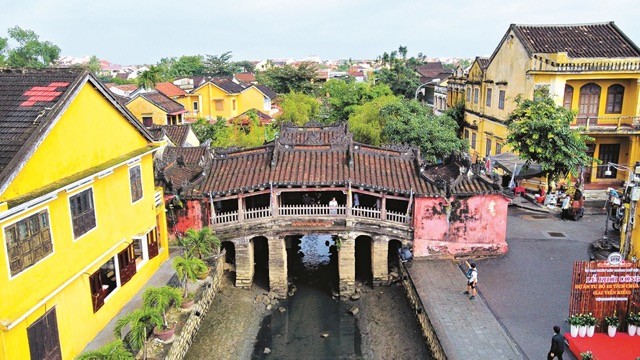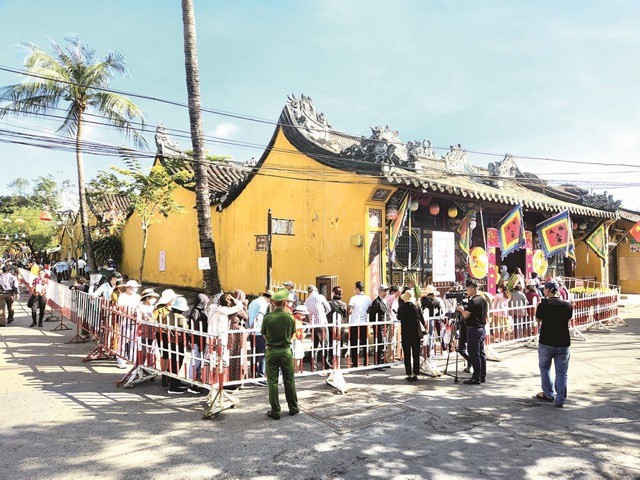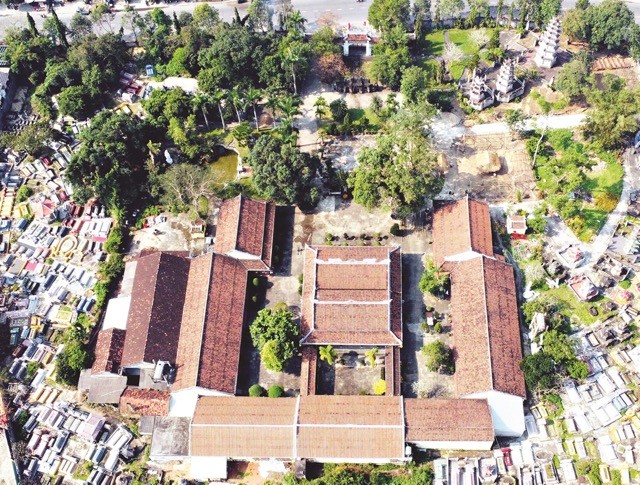Hoi An – The Land of Heritage Pagodas
1. Cau Pagoda (Chua Cau)
The first one on the list of Hoi An’s heritage pagodas is Cau Pagoda (Chua Cau). It was created for commuting. There are two parts of this relic site, “the bridge” and “the pagoda”. They are built more than half a century apart but blended seamlessly with each other to create a symbolic landmark of Hoi An.
 |
| According to researchers, the architecture alone with the two subjects “Pagoda” and “Bridge” linked together into a unified whole is unique in the architectural treasure of Viet Nam (Photo:HS) |
The temple worships a local god named Bac De Tran Vu, a spiritual figure of peace and stability in the terrain and weather of Hoi An. According to the epitaph at Cau Pagoda and other sources, this relic was built in the late 16th – early 17th centuries, restored and repaired 7 times. The latest repair took place in 1986.
Cau Pagoda also worships a pair of dogs and a pair of monkeys, representing Japanese symbols of worship landmarks. On the door of the Cau Pagoda, there is a wooden diaphragm made in 1719, embossed with 3 words “Lai Vien Kieu”, on the left is the seal of Lord Nguyen Phuc Chu.
According to Quang Nam newspaper, Vice Chairman of Hoi An City’s People’s Committee Nguyen Van Lanh said that this monument was proposed to build and invest capital by Japanese traders, but was designed, and constructed by Vietnamese people.
The Vietnamese design embodied by Cau Pagoda represents the cultural interference of both Chinese and Japanese. The Chinese designers, with their architectural thinking, are known for large-scale projects while the Japanese is known for tall structures. Instead, the Cau Pagoda has a capable size, expressing the human outlook and worldview of the local residents.
Cau Pagoda stood out among Vietnam’s tiled bridges because of its unique, harmonious Hoian-styled ecological resources and cultural heritage. Located in the heart of the old town, Cau Pagoda is a testament to the no duplicate beauty of the heritage city.
2. Ong Pagoda (Chua Ong)
 |
| A line of people offering and praying for peace at Ong Pagoda during the Lunar New Year (Photo: HS) |
Ong Pagoda (Quan Cong Temple) is located on Tran Phu Street. This street is known for its large Chinese descent community, hence the temple being a destination for the community and tourists on Chinese calendar holidays.
This site was built for the first time in 1653. It used to be considered a holy center in Hoi An. Ong Pagoda is one of the nine ancient relics in Hoi An Ancient Town that are valuable in many aspects, especially in architectural structure. Although carrying out Chinese architecture, the relic is still a remarkable structure, especially when being done by Kim Bong artisans.
Ong Pagoda has been well-preserved after several restorations, the latest being in 1966. The structure and decorations show typical temples and old pagodas in Hoi An. The temple’s structure symbolizes the Han character “Quoc” (which means country), created by many buildings standing near each other.
It also contains much beneficial information related to ethnography, sociology and more. The parallel sentences include content about the philosophy of life which has cultural values. Those sentences not only help to shape people’s lifestyles in the old society but are also compatible with building new ways of life and new people today.
3. Chuc Thanh Pagoda
The last one on the list is Chuc Thanh Pagoda. Also appearing in the flourishing period of the commercial port of Hoi An, Chuc Thanh Pagoda is one of the most ancient pagodas in the ancient town. According to Hoi An Center for Cultural Heritage Management and Preservation, Monk Luong The An is the founder of Chuc Thanh Pagoda.
The name Chuc Thanh means wishing God the best, which shows people’s gratitude towards Nguyen lords in embracing Buddhism and monks.
Chuc Thanh Pagoda (Ton Duc Thang street) was built in the late 17th century. It started as a simple cottage, but generations of monks have expanded it into a colossus as it is known today.
At dusk, the harmony between the pagoda’s foreign and domestic, traditional and modern architecture is highlighted. On the campus, there are many tomb towers of zen masters, but the most dominant one is the stupa of patriarch Minh Hai.
According to the locals, about three decades ago, despite being relatively close to the Hoi An Old Quarter, Chuc Thanh pagoda was located in a rural area. Around the pagoda, there is a scattering of willow trees and the entrance is full of sand.
 |
| Vice Chairman of Hoi An People’s Committee – Nguyen Van Lanh said Hoi An is the birthplace of the Lam Te – Chuc Thanh school, one of the biggest Buddhism schools in Vietnam (Photo:HS) |
The post Hoi An – The Land of Heritage Pagodas appeared first on Vietexplorer.com.
View more from VietExplorer:
Vietnamese rider narrowly wins 4th stage of national cycling raceKeeping our spirits up in Vietnam
Phong Luu Khau Vai Market Festival back after two-year COVID hiatus
Image of Hoi An promoted via metaverse platform
Vietnamese rider wins 6th stage of national cycling race
Man City, Liverpool share spoils in pulsating title clash
Many injured in accident near finish line in 5th stage of Vietnam’s national cycling race
Vietnam qualify for 2022 Asian Futsal Cup with win over Myanmar
SEA Games 31 opening ceremony to tell stories of bamboo and wet rice culture
The beauty of the land of hoa ban (Bauhinia Flower)
Conference seeks to unleash potential of old photo archives at Vietnamese institute
The Yellows of Hanoi
Vietnamese cyclist snatches 2nd consecutive stage win at annual national race
Russian cyclist misses chance to win 7th stage of Vietnam’s annual race
Molasses glutinous rice cake helps to put Thai Binh on the map
Get ready for holidays in Vietnam!
Stoplights as cultural treasures in Vietnam
1,000 delegates attend 13th Nation Women’s Congress
Vietnam’s Hoi An crowded, bustling on opening night of National Tourism Year
Vietnamese leaves college to become food stylist
Comments
Post a Comment